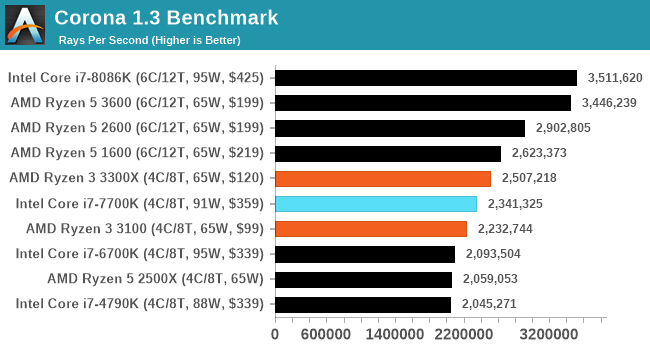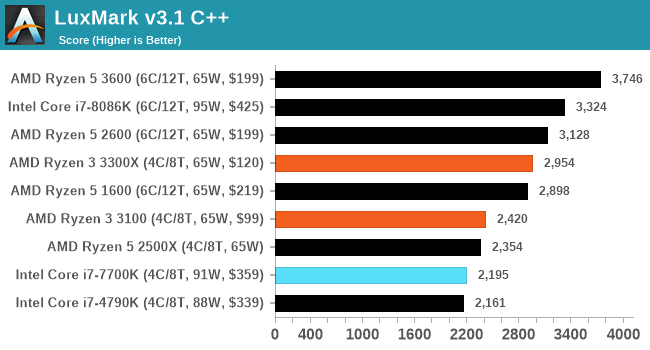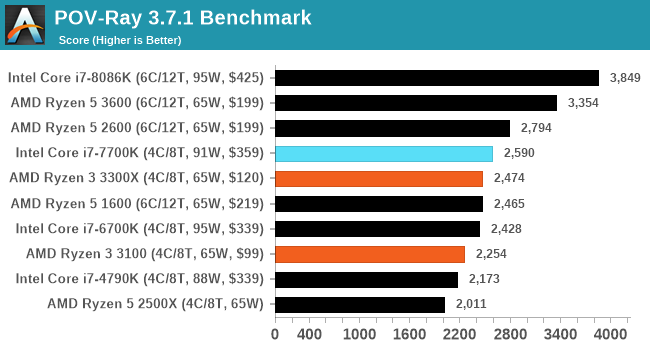The AMD Ryzen 3 3300X and 3100 CPU Review: A Budget Gaming Bonanza
by Dr. Ian Cutress on May 7, 2020 9:00 AM ESTCPU Performance: Rendering Tests
Rendering is often a key target for processor workloads, lending itself to a professional environment. It comes in different formats as well, from 3D rendering through rasterization, such as games, or by ray tracing, and invokes the ability of the software to manage meshes, textures, collisions, aliasing, physics (in animations), and discarding unnecessary work. Most renderers offer CPU code paths, while a few use GPUs and select environments use FPGAs or dedicated ASICs. For big studios however, CPUs are still the hardware of choice.
All of our benchmark results can also be found in our benchmark engine, Bench.
Corona 1.3: Performance Render
An advanced performance based renderer for software such as 3ds Max and Cinema 4D, the Corona benchmark renders a generated scene as a standard under its 1.3 software version. Normally the GUI implementation of the benchmark shows the scene being built, and allows the user to upload the result as a ‘time to complete’.
We got in contact with the developer who gave us a command line version of the benchmark that does a direct output of results. Rather than reporting time, we report the average number of rays per second across six runs, as the performance scaling of a result per unit time is typically visually easier to understand.
The Corona benchmark website can be found at https://corona-renderer.com/benchmark

LuxMark v3.1: LuxRender via Different Code Paths
As stated at the top, there are many different ways to process rendering data: CPU, GPU, Accelerator, and others. On top of that, there are many frameworks and APIs in which to program, depending on how the software will be used. LuxMark, a benchmark developed using the LuxRender engine, offers several different scenes and APIs.
In our test, we run the simple ‘Ball’ scene on both the C++ and OpenCL code paths, but in CPU mode. This scene starts with a rough render and slowly improves the quality over two minutes, giving a final result in what is essentially an average ‘kilorays per second’.

POV-Ray 3.7.1: Ray Tracing
The Persistence of Vision ray tracing engine is another well-known benchmarking tool, which was in a state of relative hibernation until AMD released its Zen processors, to which suddenly both Intel and AMD were submitting code to the main branch of the open source project. For our test, we use the built-in benchmark for all-cores, called from the command line.
POV-Ray can be downloaded from http://www.povray.org/












249 Comments
View All Comments
Ian Cutress - Thursday, May 7, 2020 - link
4790K 6700K 7700KAll Intel quad core showing generational differences as to where the 3300X and 3100 fit in.
1600X, 1700, 1700X, 1800X are all in our benchmark database, Bench.
It's practically listed on almost every page.
notb - Thursday, May 7, 2020 - link
And that's obviously great. But with that approach you could just write "3100 and 3300X added to Bench", right? :)I have nothing against the factual layer of this article. Results are as expected and they look consistent.
But it's essentially a story how an entry-level $120 CPU from company A beats a not-so-ancient flagship from company B.
So I'm merely wondering why you decided to write it like this, instead of comparing to wider choice of expensive CPUs from 2017. Because in many of your results 3300X beats 1st gen Ryzens that were even more expensive than the 7700K.
Or you could include older 4C/8T Ryzens (1500X) - showing how much faster Zen2 is.
Instead you've included the older 6-core Ryzens, which are neither similar in core count nor in MSRP.
Ian Cutress - Friday, May 8, 2020 - link
2600/1600 AF is ~$85 at retail (where you can find it), and judging by the comments, VERY popular. That's why this was included.Deicidium369 - Friday, May 8, 2020 - link
Just say AMD GOOD! INTEL BAD! that's all they are looking foreastcoast_pete - Thursday, May 7, 2020 - link
Some other sites have, and yes, the 3300 gives most of the 1st generation Ryzens a run for their money.Irata - Thursday, May 7, 2020 - link
This is a highly impressive little CPU for the money.I particularly liked the 3300X‘s good showing. If this is at least in part due to it using only one CCX, this should bode well for Ryzen 3 which should have an eight core CCX.
Look at some tests were Ryzen did not do so well wrt their Intel counterpart like Kraken and Octane - the 3300x now does very well. It even scores slightly better than the 3700x
wr3zzz - Thursday, May 7, 2020 - link
Does the B550 MB need active cooling? I can't tell from the pic.callmebob - Thursday, May 7, 2020 - link
Look at the spec graphics. Note the only difference to the old B450 is pretty much that it provides PCIe 3.0 lanes instead of PCIe 2.0.Now, when was the last time you saw a PCIe 3.0-based chipset hub needing active cooling?
As an aside, while i am kinda glad the B550 is finally coming, i am also a bit disappointed in seeing AMD (and their design/manufacturing partners) needing a better part of a year just for managing a bump from PCIe 2.0 to PCIe 3.0. PCIe 3.0 has been in the market for around eight years now; there is no excuse for AMD taking this long to figure out this s*it.
Fritzkier - Thursday, May 7, 2020 - link
Because their PCIe 3 and 4 was provided by the CPU tho. Or maybe there's an advantage of PCIe lanes provided by the chipset?callmebob - Thursday, May 7, 2020 - link
Haha, do you even know _how many_ PCIe lanes the CPU provides? Wager a guess whether it is for more than a single x16 slot?